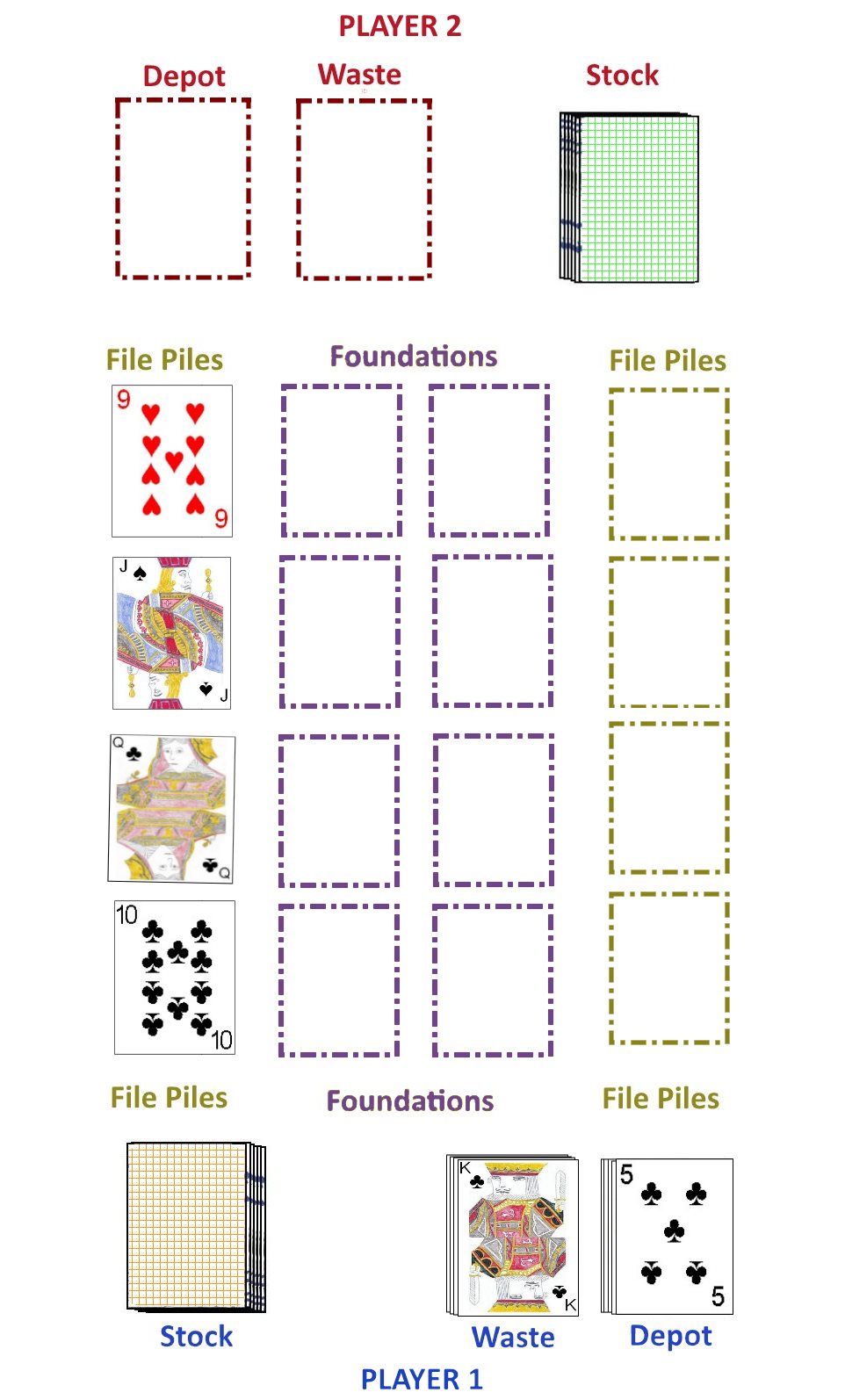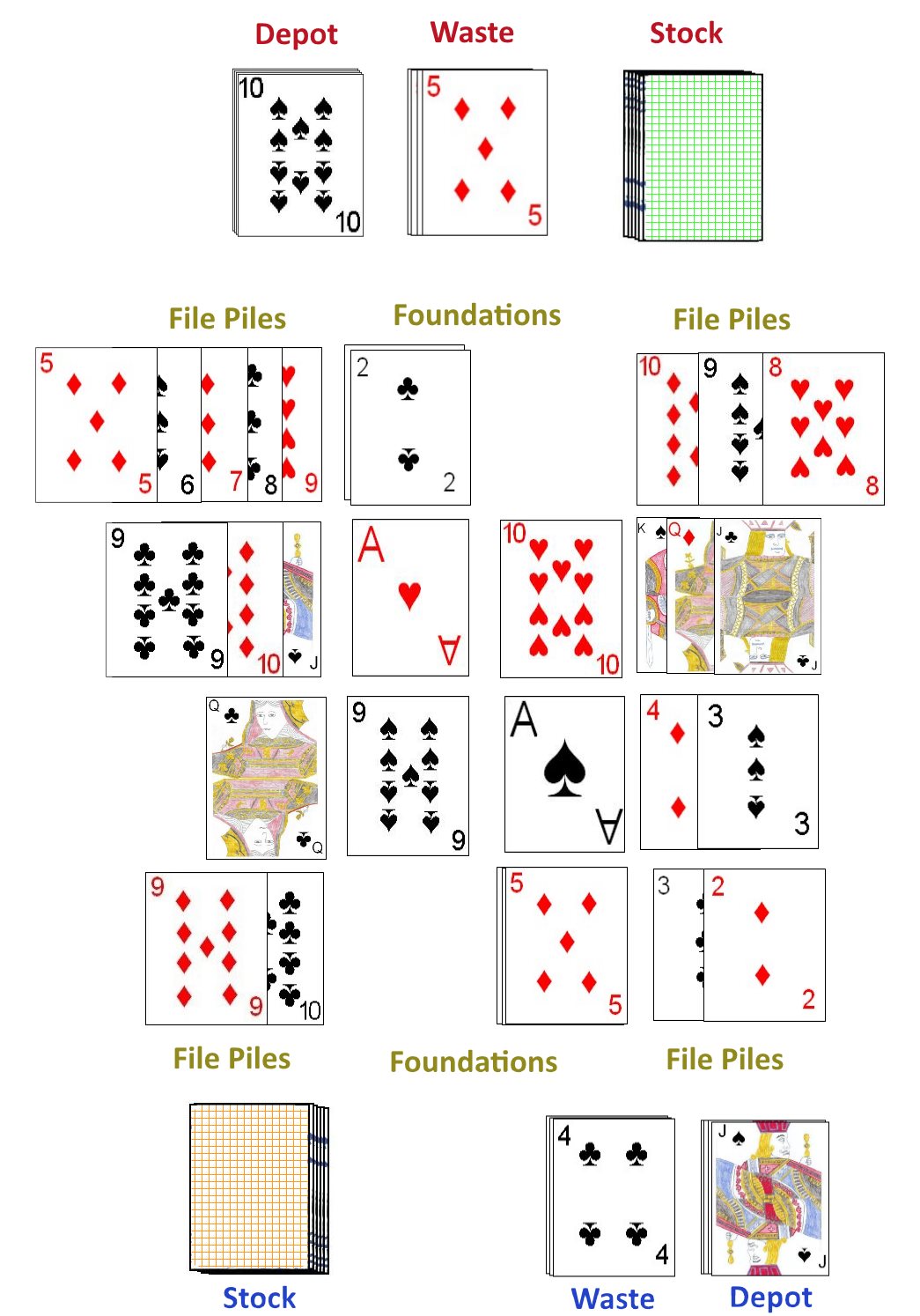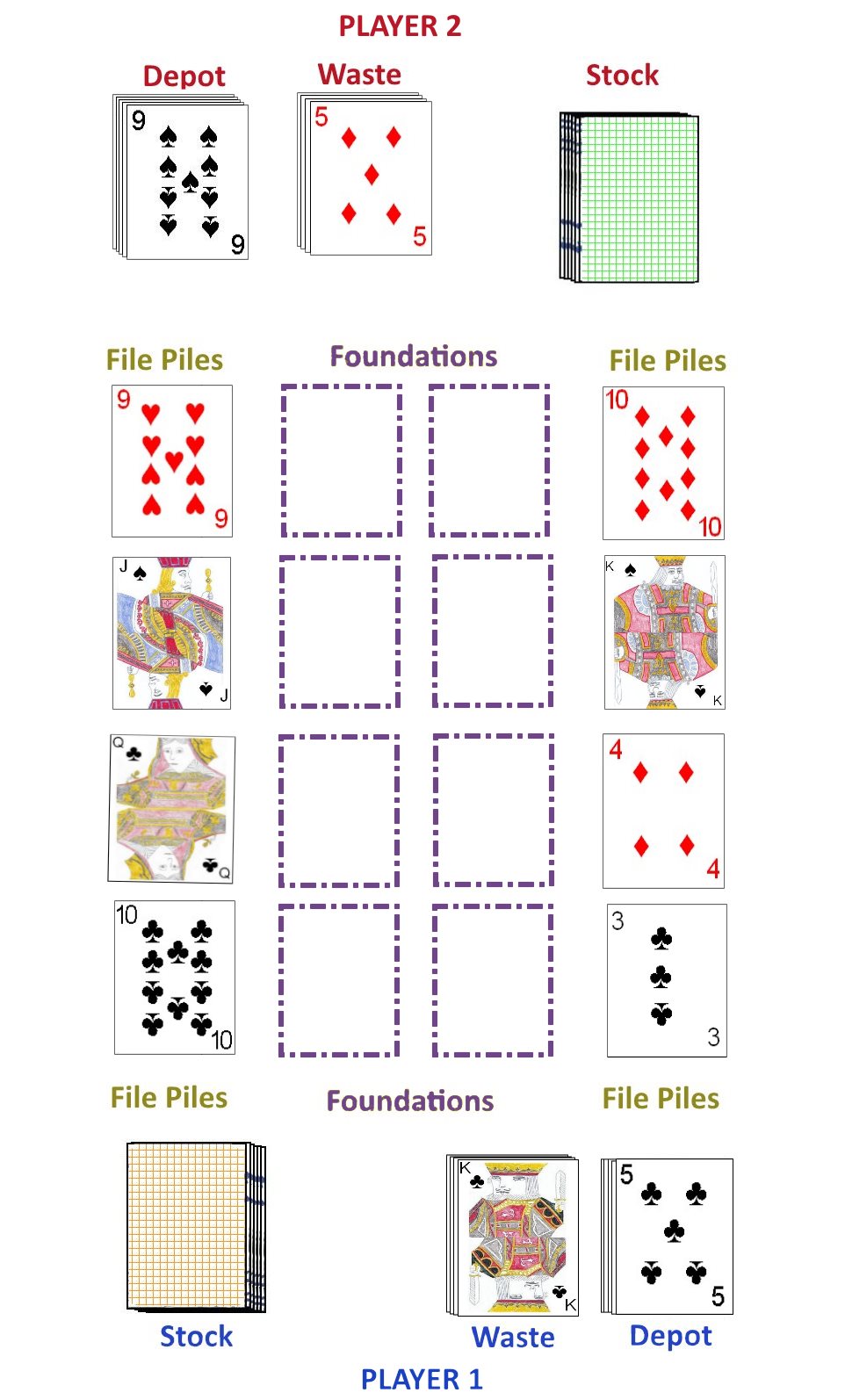Russian Bank is a fun tableau building game for two players, played somewhat similar to double solitaire and other related games. Russian Bank is designed for play by two players and uses two standard 52 card decks, one deck for each player. This game is also commonly known as Crapette, Crapot, Touch and Stop. For simplicity in dealing and gathering the cards between each hand, each decks should have a differing back design. The ranking of the cards in these decks are as follows, from high to low; King, Queen, Jack, 10, 9, 8, 7, 6, 5, 4, 3, 2, Ace.
To determine the player who will have the first turn, both players should each cut a card from either of the decks. Whichever player cuts the highest card has the first turn. If both players cut a card of the same denomination, they should each cut an additional card, with the player drawing the highest card of these new cards set as the player to have the first turn. Each hand thereafter, the deal alternates between the two players. Each player should thoroughly shuffle one pack and afterwards place that deck face-down in front of his opponent.
To begin the hand, the player who will have the first move deals 11 cards from the top of his pack to a face-down pile at his right. He then deals one more card from his pack face-up on the top of this same pile. This pile is called his depot or reserve. He then deals four more individual cards to form four piles containing one card each. These four piles are called his file.
When the layout is completed, each player will have created a file (for a total
of 8 file piles). These cards should be placed in a row at the player's right that extends across the table toward his opponent. After dealing this file, he then places the remainder of his face-down pack to his left to form his own stock pile.
 |
| The initial layout for standard Russian Bank as the first player begins his turn. |
This configuration of his layout is performed by each player at the start of that player's first turn, after which he begins his first turn. After the first turn, each player simply takes his turn as normal.
On his turn a player can continue to make legal moves until unable to continue making such plays. The following are the legal moves a player can make on his turn: Any Ace exposed as the top card on the players own depot or in any of the file piles (his own or his opponent's) may be placed to start a new pile called a foundation pile. The foundation piles should be placed between the two rows of file piles that form the
layout. If a file pile has been cleared and that space has not yet been filled, the player places the top card of his depot onto this
space. Cards from the player's own depot may be played to the foundation piles or any of the file piles. A card can be played to a file pile if it is the next lower card in sequence and of the opposite color as the current top card of that pile (i.e. red cards played on black cards and black cards played on red cards). An individual card may be played to a foundation pile if that card is of the same suit and the next highest card in direct sequence.
When a player plays the exposed top card of his depot, he must then expose the next card in the depot pile which can then be immediately used for further plays. If an Ace is the exposed card of a player's depot, he may play it to begin a new foundation
pile. The top card of a file may be played to a foundation pile if that card is the next in sequence to the current top card of the foundation pile and is of the same suit as the top card in that
pile. A player may move cards from one file pile to another file pile, as allowable. If a player manages to play the last card from a file pile to another file pile (see below) or to a foundation pile, he may then play the top, exposed card from his depot into the space formerly occupied by the cleared file pile. When moving cards from one file pile to another, the player is not limited to moving just the top card of that file pile. He may move multiple cards from the pile to another file pile, however all cards on top of the card must be moved with it. And, as any other move to a file pile, the cards must be played on a card of the next lowest rank of the opposite color. A player may play the top card of his waste pile (if this pile is not empty) to either the foundation piles or the file piles, in the same way as playing a card from his depot .A player may play cards from his own depot or the file piles to his opponent's waste pile. In order to play a card to the opponent's waste pile, the card played must be the next highest or lowest card in sequence (suit does not matter).
There are specific rules on the order in which plays are to be made by a player on his turn, which will be explained further below.
Once a player is unable to make further moves on his turn, he then turns over the top card of his stock pile, laying it beside the stock pile. If he can make a legal play with the card he may do so, turning over the next card from his stock pile. He may continue doing this until he exposes a card in which he is unable to play. When this occurs, he then places this card in a pile next to his depot, called his waste pile. To end his turn, the player then takes the new top card from his face-down stock pile and lays it on the top of the waste heap, where it will be ready for use on his next turn.
After the first player ends his turn, the second player then begins his own turn. He starts by dealing 11 cards face down in a pile from his deck to create his depot and then deals the next card face up on top of this pile. He then deals the next four cards from his deck face up in a column of four cards to create four additional file piles at his right, extending toward his opponent. He then places the remainder of his deck in a face-down pile at his left, forming his stock. He then take his own turn, in exactly the same way as his opponent.
After each player's first turn, the turn alternates between the players. Each subsequent turn is similar to the first turn, however, since the layout is already created the player simply makes any available moves, not dealing any additional cards as was done on the first turn. If, at any time a player manages to play the last card in his stock pile, the player then turns the waste pile over, face down (and not shuffling it) to begin a new stock pile. If a player's depot becomes exhausted, he may fill empty spaces left from playing the last card in a file pile from his stock pile. The game continues until a player manages to play all cards from both his stock and waste pile, at which time that player is declared the winner.
 |
| An example hand in progress during a game of Russian Bank. |
As mentioned above, the ordering of the allowable plays on a player's turn is very strict. The following list shows the specific order in which the plays must be made during a players time (if a play of that type is available): All empty spaces from cleared file piles must first be
filled. A player must play available cards from his depot before playing cards from his stock or the file
piles. A player must play cards to the foundation before playing any cards to the file piles. An empty foundation pile can only be filled with an Ace. A player must play cards to the file piles before playing a card to a waste pile. Another thing player's should be aware of while playing is that while some moves a player can make are optional, others are mandatory. The following shows the plays that a player must make on his turn, if that move can be made: If the top card of a player's reserve pile can be played to a foundation pile, he must do so and must do so as the first move of his
turn. When a card from another pile that the current player has access to can be played to a foundation pile the player must make the play. If multiple cards from other locations can be played to a specific foundation, the player has the option of which to play to the pile. If a player has any cards in his reserve pile, he must fill empty spaces in the file piles from that reserve before turning any cards from his hand pile. If a player notices another player violate any of these play ordering rules, he may immediately shouts "Stop" before that player plays any further cards, and then points out the error. The offending player's turn then immediately ends (after that player corrects the error) and the other player may then take his own turn, completing any mandatory moves of his own.
Variations and Optional Rules
 |
| Initial setup in the full layout version of Russian Bank before either player takes his first turn. |
Russian Bank - Full Layout: Russian Bank is also often played with a slightly different set of rules. This version is usually played identically to the standard game with the following differences:
- The number of cards each player deals to his reserve pile is increased by one. Thus, when creating his pile, each player deals 12 face-down cards to his reserve pile and one more card face-up to the top of that pile.
- Before play begins, both players deal their reserve pile, stock and file rows such that the initial tableau is formed before either player has his first turn.
- The first turn is determined by which player has a lower ranked card as his first face-up card on his own reserve pile. If both players have a card of the same rank as the top, face-up card of his reserve pile the cards from the files are then compared. The first card of each players initial file row is compared, with the player with the lower card having the privilege of making the first move. If these are tied then the next card in the file is compared and so on until one card is found to be lower.
- When moving a group of one or more existing cards from one file pile to another, a player may only move the entire group if there are enough open empty file pile spaces to allow the cards to be moved one at a time. In other words, moving an entire stack of cards can only be done as a shortcut for a player (instead of moving the cards one by one).
- When a player wins a hand of Russian Bank, he also earns a number of cumulative points that are carried over from hand to hand. The player who wins the hand earns 30 points for winning the hand, 1 point for each card remaining in your opponent's hand pile, 1 point for each card remaining in your opponent's waste pile and 2 points for each card left in your opponent's reserve pile. At the end of a set number of hands the player with the highest accumulated score is declared the winner.
- If the game reaches a point in which neither player can make a valid move on his turn, the current hand is considered a stalemate. The winner of the hand is the player who has a lower total count of points based on cards remaining in his own layout. Each player counts 1 point for each card left in his own waste pile, 1 point for each card left in his own hand pile and 2 points for each card remaining in his own reserve pile. The player with the lower count then scores for the hand. The amount scored is the difference between his count and his opponent's count for the hand. He does not score the 30 point hand bonus for that hand.
Copyright © 2015 CatsAtCards.com. All rights reserved.



